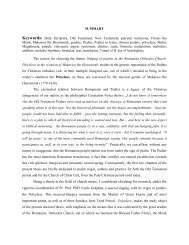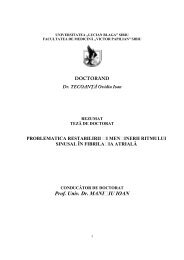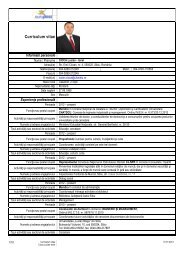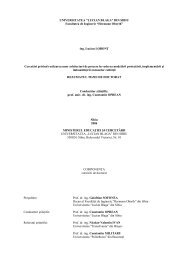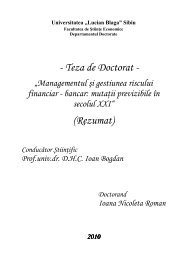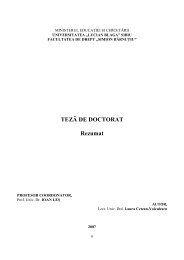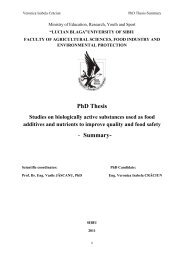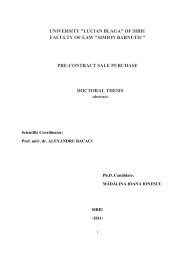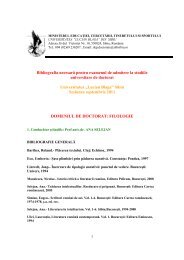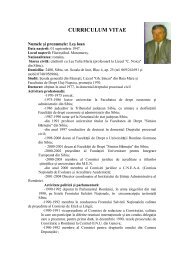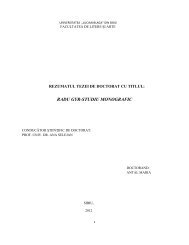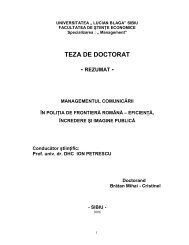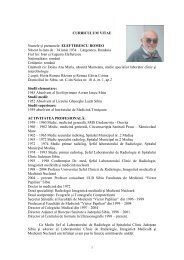omniscience, from the discourse characterized by the epistemic modality 9 , in whichelements that exclude the presence of an omniscient narrator in a classical senseappear, to the narrative in which the narrator’s unlimited knowledge is seen in thespecification he makes of the information no character has and in the proliferation ofauctorial comments.This type of narrative was considered by critics as not complying with theautodiegetic narrative in Vestibul or with that internally focalized in the next novels,but our analysis of the works has demonstrated the fact that Ivasiuc did not use it inthe most orthodox manner. Firstly, it represented the means by which the abstractauthor could express his irony towards situations and characters that ought to havebehaved exemplarily; in this situation, the nuances the author aimed at undoubtedlyrequested the existence of a model reader. Secondly, we have considered that thenarrator’s intrusions in the text can be interpreted as an expression of the desire of thenarrating instance to explicitly show its presence in the text, thus underlining theauthority and control it possesses.Besides birthing irony, with Ivasiuc the auctorial comments have three otherfunctions: generalization, interpretation or judgement, by means of which the abstractauthor polarises the reader’s sympathy, expresses his own ideology or marks thedistance between him and the narrator or between the latter and the characters.Referring to the narrative modalities, we have remarked their diversity inIvasiuc’s fiction and the fact that they change simultaneously with the movementfrom the individual’s inner world in the first novels towards the social conflict in thelast ones. Thus, the concentration on the “ontological phenomena” Liviu Petrescu 10identified in Ivasiuc’s first novels entails a proliferation of the interior monologue, animportant place occupied by the free indirect style and an almost total lack of theverbalized discourse. The works belonging to the second period of creation, morepreoccupied with the external environment, are characterized by a natural increase inthe weight of the exterior discourse and by the writer’s preference for dialogue. Apartfrom the scene, there are also excerpts transposed by means of the indirect discourseor of the narrated one.9 Paul Simpson, Language, Ideology and Point of view, Routledge, New York, 1994, pp. 50-69;10 Liviu Petrescu, Studii transilvane. Epic şi etic în proza transilvăneană, Editura Viitorul Românesc,Bucureşti, 1997, p. 63;16
In the final part of the subchapter, departing from the axis proposed by Leechand Short 11 to indicate the narrator’s control over the narrated facts and from CristianMoraru’s fin<strong>din</strong>g that “the narrator sees and knows more and more, and, therefore, isable to do more in the world of the discourse” 12 , we have made a correlation betweenthe principle of power, control and the narrator’s authority in Ivasiuc’s work, as wellas between his authority in the fictional universe and the political authority in the realuniverse. The conclusion we have come to is that there is a gradual transition from theabsolute freedom offered by the narrator to the character’s voice in Vestibul, from thecomplicity between narrator and characters in Interval, Cunoaştere de noapte,Păsările, by introducing the personal filter of the characters, to an ever stricter controlof the narrating voice over the main character by the unique voice of the narratoroutside the diegetic universe, who masters both the inner and the outer world of thecharacters, becoming a correlative of the communist oppressive tyranny.The second intratextual instance dealt with in the second chapter of the presentthesis is the narratee. The term was first mentioned by Roland Barthes 13 in his 1966study, but was left without a definition, being only introduced as the counterpart ofthe narrator in the reception of the text. The author who drew attention to the term wasGérard Genette 14 in his Discours du recit, where he defined it as “the instance whichis addressed by the narrator”, placing it thus at the same diegetic level andemphasizing its importance in the narrative discourse. Starting from the typologycoined in Discours du récit, several authors such as Gerald Prince, Shlomith Rimmon-Kenan, James Phelan developed the concept. The major novelty that their studiesbring is that related to the difference that has to be operated between concrete author,abstract author and narrator on the one hand, and concrete reader, abstract reader andnarratee, on the other hand.Like Genette 15 , Prince 16 draws attention to the fact that the presence of thenarratee has to be accepted even in those cases when the narrator seems to address noone in particular. To clarify this aspect, Prince puts forward a general portrait of the11 Geoffrey N. Leech; Michael H. Short, Style in Fiction. A Linguistic Introduction to English FictionalProse, Longman, London & New York, 1981, p. 324;12 Cristian Moraru, Proza lui Alexandru Ivasiuc, Editura Minerva, Bucureşti, 1988, p. 200;13 Roland Barthes, Introduction à l’analyse structurale des recits, în Communications, nr. 8, 1966, p.10;14 Gérard Genette, Narrative Discourse..., op.cit., pp. 259-262;15 Ibid., p. 260;16 Gerald Prince, Introduction to the study of the narrate, in Jane P. Tompkins (Ed.), op.cit., pp. 10-17;17
- Page 2 and 3: TABLE OF CONTENTSINTRODUCTION .....
- Page 4 and 5: SUMMARYThe doctoral thesis Narrativ
- Page 6 and 7: politics in Romania revealed the au
- Page 8 and 9: names began to emerge: Nicolae Breb
- Page 10 and 11: was awarded (two prizes of the Writ
- Page 12 and 13: with the text through the opinions
- Page 14 and 15: integrate elements involving both n
- Page 18 and 19: “zero degree narratee”, any dev
- Page 20 and 21: the two main directions existing in
- Page 22 and 23: portrayal, but one based on signifi
- Page 24 and 25: What the characters discover after
- Page 26 and 27: The analysis on the character also
- Page 28 and 29: internal, the focalized can be perc
- Page 30 and 31: Koppe 37 , that the relation focali
- Page 32 and 33: epresented by a proliferation of an
- Page 34 and 35: BIBLIOGRAPHYI. OPERA LUI ALEXANDRU
- Page 36 and 37: 6. Popescu-Neveanu, Paul, Dicţiona
- Page 39 and 40: 45. Neagu, Fănuş, Cartea cu priet
- Page 41 and 42: 21. Călinescu, George, Scriitori s
- Page 43 and 44: 60. Iser, Wolfgang, The Implied Rea
- Page 45 and 46: 98. Pârvulescu, Ioana, Prejudecă
- Page 47 and 48: 140. Selejan, Ana, Literatura româ
- Page 49 and 50: 14. Dimisianu, Gabriel, USR sau SSR
- Page 51 and 52: 3. Blandiana, Ana, Scriitorul şi P
- Page 53 and 54: 25. Pier, John, La narratologie all



